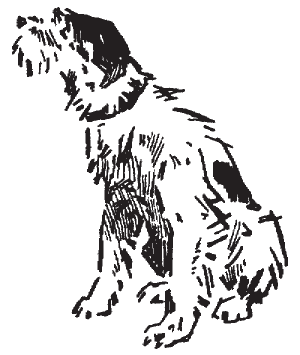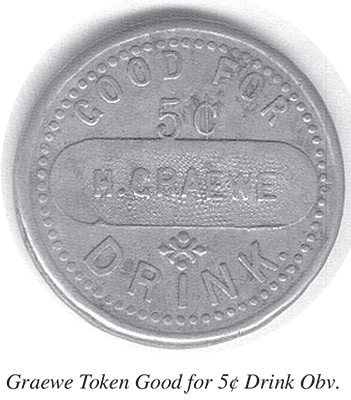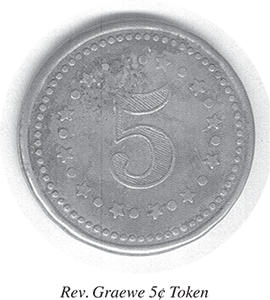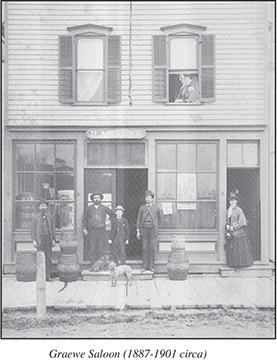
NOW Articles Written By Members
A look back at a common, but classic commemorative – Wisconsin’s Territorial Centennial
A side-tracked story: Mardi Gras Doubloons
A look back at a collecting specialty – the O.P.A. ration tokens of WWII
Bullion And Coin Tax Exemption – Act Now!
Is There A Twenty Cent Piece We Can Add To A Collection
Capped Bust Half Dollars: A Numismatic Legacy
U.S. Innovation Dollars: Our Most Under-Collected Coin?
My 2023 ANA Summer Seminar Adventure
In defense of the American Women's Quarters
A look back in numismatic history – the Hicksville Silver Dollar Hoard
The proofs so few of us collect: Jefferson Nickels
A look back in numismatic history – a story too good to be true
Kilroy promotes war bond sales
Just passing through a short-lived bank
The Kewaunee Line Encased Coin Folder
Lyman C. Draper: Collector, Historian, Genealogist
>> More articles in the Archive
For more NOW Articles Written By Members,
<< More articles in the Archive
Watertown’s Herman Graewe and His Counterfeit Sniffing Dog
[by Tom Casper #982]
 After recently finding a photo of the H. Graewe saloon and already owning a saloon token from there, I needed to find out something about him. Herman Graewe was born in August 6, 1849 and emigrated here from Germany. It turns out he was a man of many talents which included a butcher, saloon proprietor, deputy sheriff, and alderman.
After recently finding a photo of the H. Graewe saloon and already owning a saloon token from there, I needed to find out something about him. Herman Graewe was born in August 6, 1849 and emigrated here from Germany. It turns out he was a man of many talents which included a butcher, saloon proprietor, deputy sheriff, and alderman.
Graewe first appears in the 1875-76 Watertown, WI City Directory as operating the Graewe & Kisow Meat Market, (Herman Graewe & Charles Kisow). His only appearance in the U.S. Census’ was in 1880. He is listed as a butcher, age 30, with his wife Lina 23 and their son, Charlie 4.
In the 1885 Watertown directory he is listed as operating the Herman Graewe and Gustav Boehm Meat Market. In 1887 he changed careers and opened up a saloon under his name. He continued operating his saloon in 1889 but now he also became a deputy sheriff. According to the 1892-93 directory he got out of the saloon business but continued as a deputy sheriff. In 1893 he became an alderman. In 1897 he went back to the meat market business. About 1899 he moved to the nearby city of Lowell, WI. The 1899-1900 & 1901-02 Polks Wis. Gazetteer lists him as operating a saloon there. He died October 25, 1901 at age 52 and is buried in Oak Hill Cemetery in Watertown.
 While researching him, I came across a fascinating newspaper article published in the January 14, 1888 issue of The Daily Northwestern in Oshkosh, WI. The story came from Watertown, WI and was titled, “A Dog Detective - One in Watertown that can Pick Out Counterfeit Coins”.
While researching him, I came across a fascinating newspaper article published in the January 14, 1888 issue of The Daily Northwestern in Oshkosh, WI. The story came from Watertown, WI and was titled, “A Dog Detective - One in Watertown that can Pick Out Counterfeit Coins”.
In the article, a well known citizen relates the following story about a dog in Watertown. The man had expressed doubts about the story he heard, so a fair trial was done in his presence.
 A man by the name of H. Graewe of Watertown owned a Russian terrier, eight months old named Topsey. The man telling the story said he mixed several good silver coins from the drawer and some half dozen counterfeit coins from a rubbish box. The coins were thoroughly mixed. The dog then spread out the coins with his paw and without hesitation selected the good coins from among the counterfeits by taking them up with his teeth and placing them on one side. This was done in every instance with coins that he had not seen before, and without a single error. He then gave the dog another test. He rolled different coins along the floor. If the coin was a counterfeit, the dog paid no attention to it whatever. If it was a good one he would catch it before it stopped rolling and held it in his mouth until told to return it. Although the article doesn’t mention it, these tests were probably performed in Graewe’s saloon.
A man by the name of H. Graewe of Watertown owned a Russian terrier, eight months old named Topsey. The man telling the story said he mixed several good silver coins from the drawer and some half dozen counterfeit coins from a rubbish box. The coins were thoroughly mixed. The dog then spread out the coins with his paw and without hesitation selected the good coins from among the counterfeits by taking them up with his teeth and placing them on one side. This was done in every instance with coins that he had not seen before, and without a single error. He then gave the dog another test. He rolled different coins along the floor. If the coin was a counterfeit, the dog paid no attention to it whatever. If it was a good one he would catch it before it stopped rolling and held it in his mouth until told to return it. Although the article doesn’t mention it, these tests were probably performed in Graewe’s saloon.
Pictured here is a token from Graewe’s saloon. It reads, “Good For/5c/H. Graewe/ Drink/5. It is nickel, round, 23mm. The token was probably used at both of his saloons.
 Shown here is a photo of his saloon. Above the entrance is the sign, “H. Graewe”. There is no writing on the back indicating who the people are in the photo. I assume Graewe is standing on the right side of the entrance wearing a derby and watch chain with his son, Charlie next to him. Also in the picture are two dogs with one of them probably being the infallible counterfeit detector.
Shown here is a photo of his saloon. Above the entrance is the sign, “H. Graewe”. There is no writing on the back indicating who the people are in the photo. I assume Graewe is standing on the right side of the entrance wearing a derby and watch chain with his son, Charlie next to him. Also in the picture are two dogs with one of them probably being the infallible counterfeit detector.
The token and photo are circa 1887-1901, the years he is listed as operating a saloon. The only remaining mystery is whether the saloon picture is from Watertown or Lowell.
Sources:
U.S. Census 1880
Watertown City Directories-1875-76, 1885, 1887, 1889, 1892-93, 1897, 1899-1900
www.newspaperarchive.com-The Daily Northwestern January 14, 1888.
R. L. Polk & Co. Wisconsin State Gazetteer 1899- 1900, 1901-02
Have an interesting numismatic topic you’d like to share with your fellow NOW members?
Send your article to evan.pretzer@protonmail.com today!!!